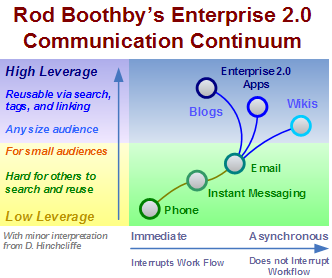The Enterprise 2.0 industry discussion continues and evolves

A pair of new articles over on the Sandhill site explores the increasingly discussed topic of Enterprise 2.0, an important Web 2.0 offshoot that I've covered over the last few months. While a lot of folks are taking a wait and see attitude to the application of low-barrier, emergent, social software to enable ad hoc business processes, it's nevertheless a topic of interest in many IT and business circles.
The first piece, by M.R. Rangaswami, talks about The Birth of Enterprise 2.0, saying:
Enterprise 2.0 is more than just Web 2.0 for business. Enterprise computing is far more complex than personal computing. It includes legacy environments, innumerable vendors, mismatched data sources, stringent regulations and far flung users. While Web 2.0 can deliver genuine advantages for both business users and consumers, the real "Enterprise 2.0" will encompass a far broader and more complex vision.
Rangaswami also notes that he believes ultimately that the emergent, decentralized, ad hoc software which leverages the tenets of Enterprise 2.0 will let "a thousand flowers bloom" within organizations that embrace it.
The second piece written by Vinnie Mirchandani, is titled The Bionic Enterprise Software 2.0, an apparent reference to the amalgam of people-power and computing power that forms when small, loosely-coupled pieces of software suddenly gel together into a piece of situational software (or at least that's my take.)
More significantly, Mirchandani takes Andrew McAfees powerful, compact definition of Enterprise 2.0 and fully provisions the definition -- with help from The Irregulars mailing list -- for the enterprise crowd, complete with a list of critical aspects that provide the necessary Web 2.0-like feedback loops to make sure the right software emerges. This list cites the features that effective Enterprise 2.0 platforms will likely have:
a) supports choice of customer deployment of functionality as a service, and in installed mode
b) is architected and priced/sold as a series of services
c) sells maintenance broken in to support and upgrade charges and allows an ecosystem of partners, not just the publisher, to alternatively provide support.
d) largely automates bug fixes/upgrades which require little customer (or service partner) intervention
e) provides process management, configuration, conversion, integration, testing, systems management, end user training tools to minimize implementation and support labor
f) provides customers with a wide range of service partners which are audited, graded and certified each year based on product training completion, customer feedback,
g) commits to transparency to customers around product quality, customer service ticket resolution, outages (where provided in SaaS mode) etc.
h) provides a mechanism for certification of integration of third party software products, and re-certification as releases change
i) actively encourages a on-line developer/integrator community and pushes for an "open source" licensing of community intellectual property
j) commits to sharing with each customer a "sticker" showing standard list of various components/services and various discounts and taxes
k) shares with customer base on a regular basis summary results of various implementation and support metrics from its service partner ecosystem
But it was Rod Boothby that made the most visually striking addition to the Enterprise 2.0 conversation this week by describing something he calls The Enterprise 2.0 Communications Continuum, a visual of which I redid below while also taking a few liberties I'll mention in a moment.
Rod observes that traditional collaboration tools such as the phone, instant messaging, and e-mail are high effective, but no very leveragable, while blogs and wikis capture information for a mass audience that can then be found and reused. All of us on the Web take advantage of this fact daily through the growing body of knowledge in the blogosphere and find what we need quickly via search, recommendation engines, and filters.

In my version of Rod's diagram, I added Enterprise 2.0 Apps between blogs and wikis, a generic reference to collaborative apps that reflects a key point that Andrew McAfee made this week about the current emphasis on blogs and wikis as the key technologies of Enterprise 2.0, something he cautions against, saying that the picture is significantly larger than that:
There’s a danger in confining our discussion of Enterprise 2.0 technologies to blogs and wikis. I imagine Tom considered only these two because of space considerations, but I’ve noticed elsewhere a tendency to equate Enterprise 2.0 with corporate blog + wiki use. This viewpoint is far too narrow. The phenomena, and the supporting technologies, of initially freeform and eventually emergent collaboration are rich and varied; let’s try to make sure we’re not leaving any of the important ones out.
In fact, as I've discussed before about user generated software and situational applications, the burgeoning world of user generated Web 2.0 approaches like mashups and extendable two-way software aka "spaces", will be the way much of this happens.
Many folks are looking for evidence or even great stories about the effectiveness of blogs, wikis, and social software in the enterprise. Pl;ease drop a line